Rotherham, West Riding of Yorkshire
Up to 1834
Rotherham's first workhouse was probably the "Cottage Workhouse" on The Crofts. This was set up in 1659 in leased premises following a legacy of £100 left to Rotherham's poor by the Earl of Shrewsbury in 1617 and gift of £40 from Thomas Colte. It was run by a local body of property owners called the Feoffees.
A parliamentary report of 1777 recorded a local workhouse in Rotherham with accommodation for up to 40 inmates. Parish workhouses or poorhouses also existed at Rawmarsh, Laughton and Bramley.
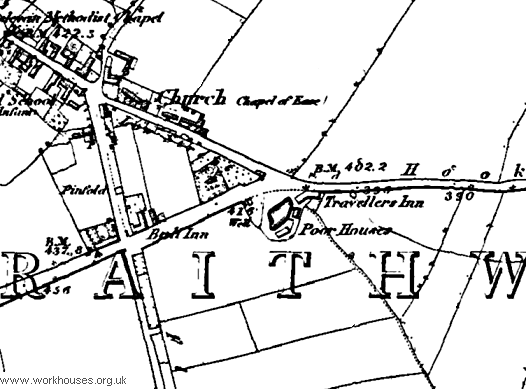
Bramley poorhouse site, 1854.
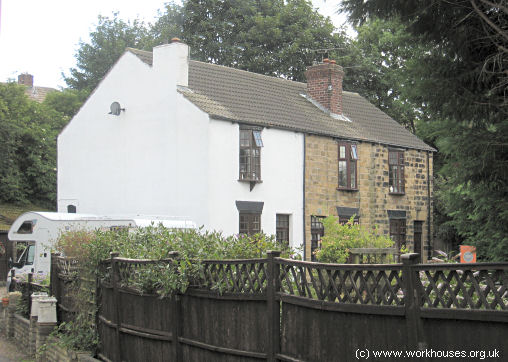
Bramley former parish poorhouse site, 2009.
© Peter Higginbotham.
After 1834
Rotherham Poor Law Union officially came unto existence on 1st July, 1837. Its operation was overseen by an elected Board of Guardians, 31 in number, representing its 28 constituent townships and parishes as listed below (figures in brackets indicate numbers of Guardians if more than one):
West Riding of Yorkshire:
Aston-cum-Aughton, Bramley, Brampton Bierlow, Brampton-en-le-Morthern, Brinsworth, Catcliffe, Dalton, Greasborough, Handsworth (2), Hooton Levett, Hooton Roberts, Kimberworth (2), Laughton-en-le-Morthern, Maltby, Orgreave, Ravenfield, Rawmarsh, Thrybergh, Tinsley, Treeton, Rotherham (2), Swinton, Ulley, Wath-upon-Dearne, Wentworth, Whiston, Wickersley.
County of Derby:
Beighton.
The population falling within the Union at the 1831 census had been 25,881 with townships and parishes ranging in size from Orgreave (population 35) to Rotherham (4,083). The average annual poor-rate expenditure for the period 1834-36 had been £7,822 or 6s.1d. per head.
The Board of Guardians had their inaugural meeting on 3rd July, 1837, and Earl Fitzwilliam was elected Chairman. A clerk was appointed at a salary of £80 per annum, and four medical officers at £75 per annum covering Rotherham, Wath, Aston and Maltby. In February 1838, the Guardians purchased five acres of common land from the Feoffees for the sum of £1,000 on which to build a new workhouse. The site was in an elevated position at the south side of Alma Road. On the 5th June, 1838, the Poor Law Commissioners agreed a loan of £6,000 for construction of the building which began almost immediately. The following year, a further loan of £800 was needed to cover additional costs. The workhouse was opened by the end of July, 1840 and could accommodate 300 inmates.
The main workhouse building was a three-storey structure, constructed from sandstone with a slate roof. Side wings, running east-west, together with the arched entrance block, formed a quadrangle at the west of the site. To the rear, the accommodation adopted the cruciform arrangement of blocks radiating from a central hub where workhouse staff could supervise the inmates. Females were accommodated at the north of the site, and men at the south. A hospital block lay at the east of the site. The workhouse layout is shown on the 1851 map below.
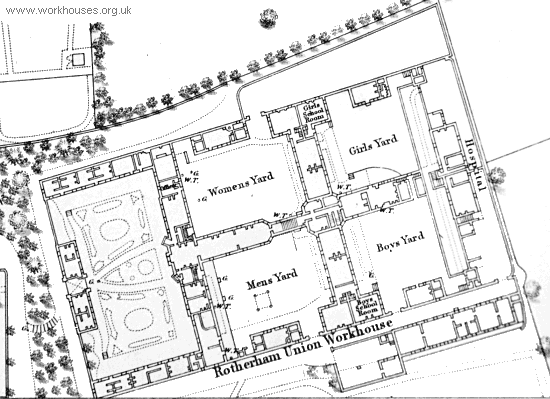
Rotherham workhouse site, 1851.
A workhouse inspector's report in January 1867, recorded that the inmates included 140 old and infirm and about sixty children. There was only one nurse for 140 patients, the condition of the sick wards was poor, the sanitation was defective, and the building needed repainting. Between 1866 and 1870, a lunatic ward and infectious diseases ward were built. Following an outbreak of smallpox in Rotherham in 1872, the workhouse was used for isolation purposes and out of 141 people admitted, 22 died.
An new hospital building was erected in 1886-8 at the south of the workhouse and was designed by local architect HL Tacon. It had four large wards, day rooms, lying-in wards, kitchen, surgery, nurses' rooms etc. It was 235 feet in length and could accommodate a total of 52 male and 52 female patients. Following the opening of the new hospital, the old hospital block was turned into a school building. The site layout at around this stage are shown on the map below from the early 1890s.
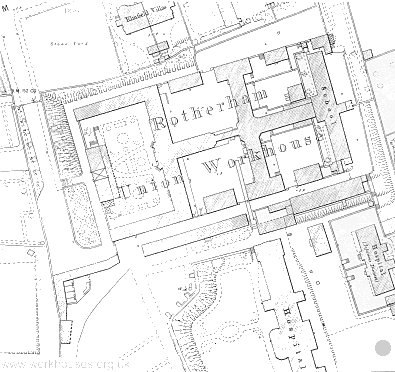
Rotherham workhouse site, 1890s.
In 1894, a major rebuilding of the workhouse took place. This provided a new master's house and offices, board room, vagrants' and receiving wards, lunatic wards, able-bodied blocks, dining hall, new foul wards and isolation hospital, workshops, stables, etc. The layout of the refurbished site can be seen on the 1904 map below:
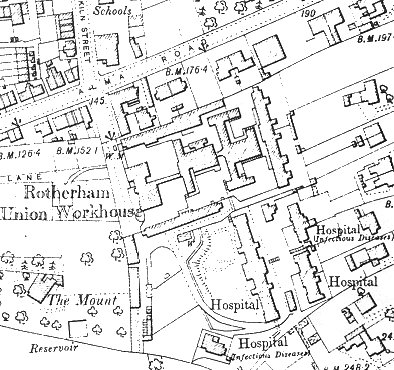
Rotherham workhouse site, 1904.
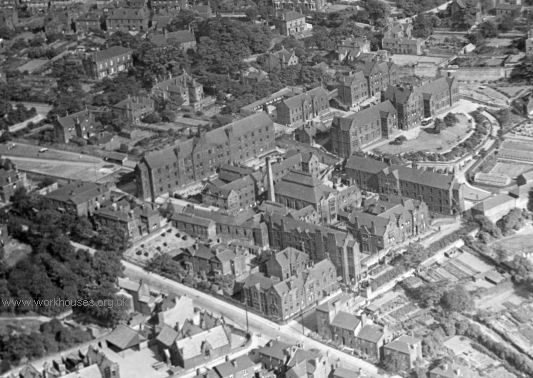
Rotherham aerial view of site from the north-west.
© Rotherham Metropolitan Borough Council, Archives and Local Studies Service.
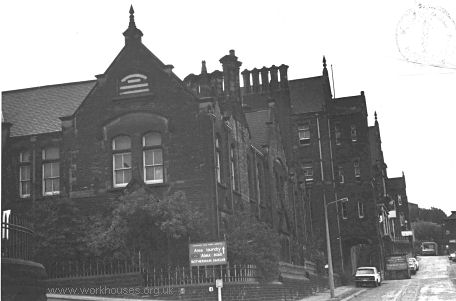
Rotherham site entrance from Alma Road.
© Rotherham Metropolitan Borough Council, Archives and Local Studies Service.
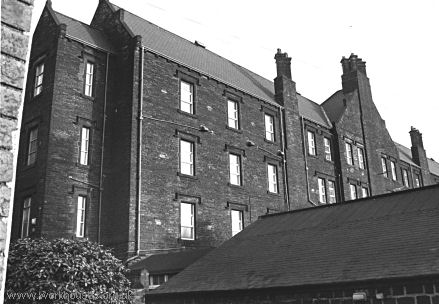
Rotherham former workhouse block at east of site.
© Rotherham Metropolitan Borough Council, Archives and Local Studies Service.
After 1930, the workhouse became the Alma Road Public Assistance Institution, then subsequently Moorgate General Hospital, with its main entrance on Moorgate.
The hospital closed in around 1980 and almost all the buildings were demolished in the late 1980s. By 2001, only a few small derelict sections of the workhouse remained.
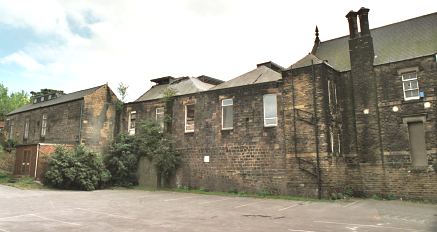
Rotherham northern edge of site from the north, 2001.
© Peter Higginbotham.
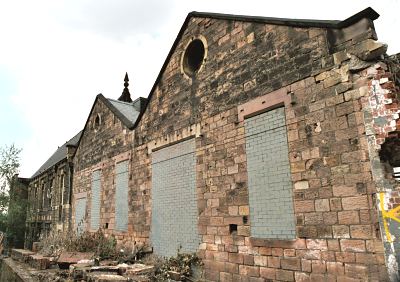
Rotherham northern edge of site from the east, 2001.
© Peter Higginbotham.
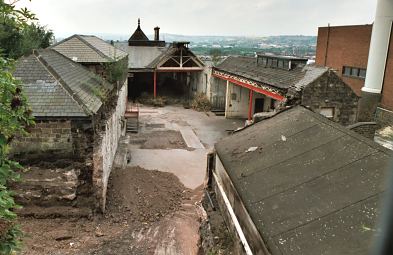
Rotherham site elevated view from the east, 2001.
© Peter Higginbotham.
Children's Homes
In 1902, a number of villas along Alma Road, at the north of the workhouse, were converted into children's cottage homes. Two other properties, at 37 St Ann's Road and 22 Clifton Terrace, Rotherham, were also later used as children's homes.
Staff
Inmates
Records
Note: many repositories impose a closure period of up to 100 years for records identifying individuals. Before travelling a long distance, always check that the records you want to consult will be available.
- Rotherham Archives and Local Studies Service, Clifton Park Museum, Clifton Lane, Rotherham, S65 2AA. Holdings comprise: Guardians' minute books (1837-1930 with gaps); Births (1848-79, 1912-38); Creed registers (1883-1894, 1897-1932); Inmates' relatives (males only, 1887-91, 1911-32 with gaps); Register of vagrants and remand cases (1921-40); Master's journal (1913-48); etc.
Bibliography
- Drinkall, M (2009) Rotherham Workhouse (The History Press)
Links
- None.
Unless otherwise indicated, this page () is copyright Peter Higginbotham. Contents may not be reproduced without permission.


